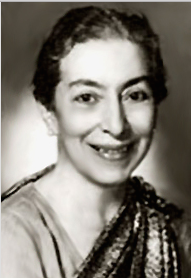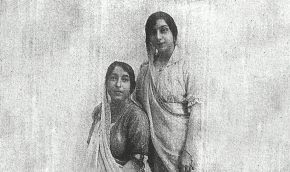This post originally appeared on Murder Is Everywhere.

True tales of women breaking barriers to forbidden places, and bettering the lives of others, are inspiring. Mithan Jamshed Lam is one of these legendary women. Recently I chatted about this illustrious lady (who passed away in 1981) with another woman who is doing important civil rights work in contemporary India, the Mumbai solicitor Parinaz Madan. In an interesting twist, Parinaz is married to Dinyar Patel, a professor and author of Naoroji: Pioneer of Indian Nationalism.
I was fortunate enough to meet Parinaz and Dinyar in real life last January at the Royal Bombay Yacht Club in Mumbai. We dined on a delicious biryani and many other dishes as we discussed the history of the city and the freedom movement. They are both Parsis and have been kind enough to also answer my questions about the minutiae of the community’s cultural life. Their assistance was key in creating realistic social situations in my forthcoming novel, The Bombay Prince.
Last year, Parinaz and Dinyar wrote an article for BBC News about Bombay’s first woman barrister, Mithan Ardeshir Tata, known after her marriage as Mithan Jamshed Lam. In 1924, Mithan became the first woman advocate permitted to argue cases at Bombay’s High Court. Mithan’s education, family background, and relentless struggle for women’s rights were influential in the development of my series protagonist, Perveen Mistry.
It was much harder for me to find scholarly material about Mithan than Cornelia Sorabji. In 2016, I bought a reprint of her autobiography, Autumn Leaves, at the K.R. Cama Oriental Institute, a center for Parsi scholarship. The autobiography is dominated by the stories of Mithan’s world travels. I wanted to know specifics about her life in India, so I’ve put some questions to Parinaz about her.
Were Mithan’s parents encouraging of her career choice as a lawyer? Were there any other events in her youth that pushed her toward the field?
Mithan’s autobiography lends the impression that her family had very progressive leanings.
She describes her father Ardeshir as a man of “liberal views” who wholeheartedly backed her academic pursuits. In fact, her father spurred his studious wife Herabai to complete her B.A. degree, by employing a number of tutors for her.
Mithan also seems to have shared a very close and almost sororal bond with her mother, which is not surprising, considering that they were separated by only seventeen years in age!
As a teenager, Mithan was clearly inspired by her mother’s social activism and commitment to securing equal voting rights for women and that likely set the stage for her active participation in the female suffragist movement subsequently. She was all of 21 when she was chosen, alongside her mother, to deliver evidence on the necessity of female suffrage in India to the British Parliament.
Mithan had a stellar academic track record even before studying law: she obtained her B.A. from Elphinstone College, Bombay and was the first woman to be awarded the Cobden Club Medal for securing the highest marks in Economics. She then went on to pursue an M.Sc. degree from the London School of Economics, while her mother was studying for a Social Service course at the same university.
Since Mithan’s childhood and early life were steeped in political and social activism, law may have seemed to be the most natural career choice for her. She probably recognised the potential of a legal career to create lasting and meaningful reform in areas that she deeply cared about, such as women and children rights, and was ably supported by her parents along the way.

Cornelia Sorabji is arguably the most renowned female lawyer from colonial India. Her career was divided between private practice in a firm with her brother in Allahabad, and many more years working throughout India as a legal investigator for the Indian Civil Service. She was almost 31 years older than Mithan, but was called to the Bar in Britain (i.e. admitted to practice in courts) after Mithan. Could you explain why that happened?
Yes, Cornelia was the first woman to study law at Oxford in 1889 (nearly a decade before Mithan was even born). However, she could not be called to the Bar after finishing her law exams because women were prohibited from practicing law in Britain, until the passage of the Sex Disqualification (Removal) Act, 1919.
This Act which opened the doors for women to be admitted to the Bar in the United Kingdom was passed only in 1919. Mithan who was fortuitously in London at the time was admitted to Lincoln’s Inn in 1920, followed by Cornelia who returned from India to Britain two years later. Mithan became the first woman to be called to the Bar at Lincoln’s Inn in January 1923 when she was 24. Cornelia was actually called to the Bar a few months later than Mithan in June, when she was 55.
Providentially, the Indian government also abolished restrictions on women to practice law in 1923: the same year that Mithan set sail to India after finishing her studies in London. This enabled her to kickstart her legal career as the first female lawyer in the Bombay High Court in 1924. I think she sums all this up quite aptly in her autobiography: “I must have been born under a lucky star, for I always found myself in the right place at the right time.”
What was Mithan’s life like when she started working as a barrister? Did you uncover any stories of success and struggles against discrimination?
Ironically, Mithan bagged her first legal case from a client who wanted to “inflict upon the opponent the humiliation of being defeated by a woman.” She recalls feeling like “a new animal at the zoo” while appearing in court, arousing the curiosity of men who peeped through its doorways to catch a glimpse of this unique species. Understandably, this made her feel extremely “self-conscious”. Such acts of discrimination notwithstanding, newspaper records reveal that Mithan practiced in court for about 15 years from her enrolment as a lawyer in 1924 in India.
Mithan was extremely outspoken on women’s rights. Tell us about some of her work in that area, and the legislation she proposed.
Apart from the female suffrage activities that Mithan is renowned for, she was a staunch advocate for amending marriage, divorce, inheritance and guardianship laws in India to make them fairer to women, often drawing upon international legislation. As a Zoroastrian herself, her legal expertise was sought in reforming the laws for marriage and divorce in the Parsi community.
One of the women’s organisations that she was most prominently associated with was the All-India Women’s Conference. As its President, she propounded a shift of focus from “sewing and cutting classes” for women to their more active participation in industries and emphasised on the need for family planning. She also encouraged women to take a more active role in civic engagement and public works in the country. After the partition of India in 1947, Mithan was tasked with being the Chairperson of a committee constituted for resettling refugee women and children in Bombay.
But her activism was not restricted to only women’s issues. She also spearheaded hunger eradication programs, anti-child labour advocacy and slum improvement projects in India. In 1928, she joined protests with the Bombay Youths League about a proposed school fee hike for secondary education in India. The Bombay Chronicle noted “The ridiculous plea that higher education should be further taxed to find funds for primary education is aptly described by Miss Tata as the policy of robbing Peter to pay Paul.” These protests may have had a hand in the government backing down on the fee hike attempt for colleges and schools eventually.
Mithan married in 1933, probably at age 35. Do you know anything about her husband Jamshed Lam’s feelings about her continued activism and legal activities?
I will let Mithan’s autobiography do the talking for this question. She describes Jamshed, a lawyer himself, as “a wonderful and loving husband” who “was proud of my achievements and helped to advance me in every way….I have been greatly lucky in my menfolk–a liberal father of very advanced views, a loving and generous husband, and a fine son of whom any parent would be very proud.”
How do you describe Mithan’s legacy for women in India?
Mithan left behind an invaluable legacy for women in the legal profession and beyond. Demolishing patriarchal stereotypes of what a woman can and cannot achieve, particularly in traditionally male-dominated fields, was the cornerstone of her career.
While Mithan was a woman of many firsts, she did not work in silos but mentored scores of other women. Prominent among them was Violet Alva who was a law student at Government Law College, Bombay when Mithan was a professor there. Violet subsequently went on to become the Deputy Home Minister of India and the first female Deputy Chair of the Rajya Sabha (the Upper House of Parliament). Examining the life stories of trailblazing women like Mithan makes us realise that a lot of rights that we, as Indian women, enjoy today, such as the right to vote or work, were achieved on the back of the unwavering efforts of such pioneers.

As a solicitor in Bombay, you work hard as legal advisor at a prominent company, yet you make time for pro bono work. Tell us about the pro bono organization you work with.
In addition to the corporate law work I do, I am also a member of iProbono. It is a global organization which connects lawyers with non-profits and social enterprises in need of pro bono legal assistance. Over the past few years of my association with iProbono, my work has involved advising schools, innovations labs, mental health professionals and organisations working for the underprivileged on a number of education, child rights, disabilities and medical laws in India.
Law is a very potent instrument for social change and I believe that in a developing country like India, especially, there is tremendous scope for lawyers to create systems and establish precedents from the ground up.
You’ve said that India has some of the strongest child abuse laws in the world, but these laws aren’t often exercised properly. Can you give an example of how this could be changed?
In 2019, the Economist Intelligence Unit published a report evaluating the response of sixty countries, across the development spectrum, to the scourge of child abuse. Interestingly, India ranked the highest amongst all the surveyed countries in terms of the strength of its legal framework for protecting children from sexual abuse and exploitation. However, awareness of these laws remains low and their implementation remains challenging, given the high rates of child abuse in the country.
Now, child abuse is a very pervasive and complex problem and its eradication needs resolute engagement from various stakeholders, both government and private. However, one of the ways in which organisations interacting with children (like schools, children’s shelters etc.) can mitigate child abuse is by developing effective child protection policies, as an article I’ve recently written demonstrates. Such policies typically contain a blend of preventive and remedial child protection measures. In the absence of such policies, organisations often deal with child abuse incidents arbitrarily and without regard to the law, causing grave prejudice to the interests of children under their care. Through iProbono, we assist various civil society organisations in drafting and implementing child protection policies, to foster a safe and child-friendly environment.
The pandemic has many people working from home. Do you see this is an opportune time for more persons with disabilities (PWDs) to have a chance to enter the Indian workforce? What are the factors that make it difficult for PWDs to work? Is there a national law in existence for enabling disability inclusion in the workplace?
The employment rates of PWDs in the Indian corporate sector are abysmally low barring, of course, a few outliers. A study published by the Business Standard in 2019 noted that PWDs constitute less than 0.5 per cent of employees in India’s top companies. In India, the Rights of PWDs Act, 2016 is a national-level legislation that requires companies to develop equal opportunity policies and create an accessible environment for their employees, but its implementation remains patchy.
Historically, taboos associated with disabilities and low literacy levels have kept a lot of PWDs out of the workforce. Social isolation and a lack of employment opportunities, posed by the Covid-19 crisis, have hit PWDs further.
But, some disability rights activists see a silver lining to this crisis: the pandemic has impelled companies to adopt remote working policies and technologies which certain groups of PWDs have long demanded as reasonable accommodations. Needless to say, it is imperative that such technologies are designed to be accessible to PWDs, to facilitate their meaningful participation in work. In a 2020 piece I wrote for Business Standard, I’ve argued that there is a strong legal, business and moral case for disability inclusion in the Indian corporate sector, particularly in the light of the pandemic. I think the ILO’s Director-General summarizes the essence of this fittingly: “A disability-inclusive response means a better response for us all.”
